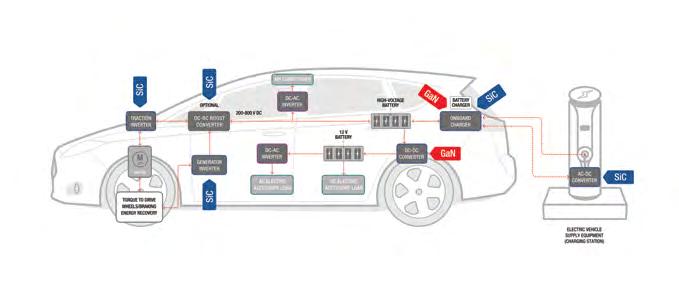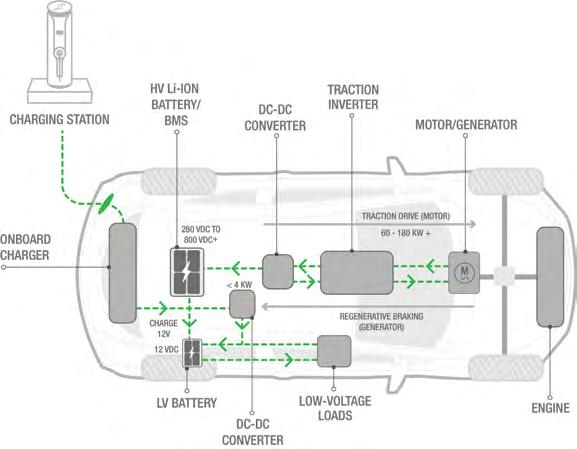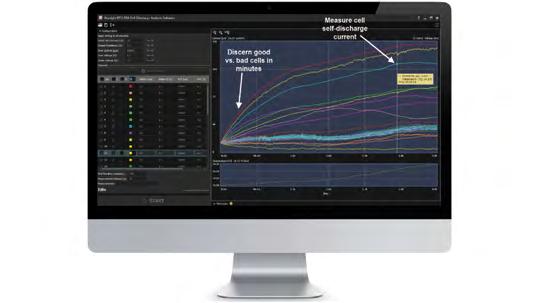
6 minute read
The energy ecosystem – technologies driving the
The energy ecosystem - technologies driving the future of e-mobility
by Hwee Yng Yeo, Industry Solutions Manager, Automotive and Energy, Keysight Technologies
Recent innovations in design and test methods are presented.
Ms Hwee Yng Yeo
Climate concerns and evolving consumer preferences are driving technology innovations for electric vehicles (EVs), as a means towards a greener transportation future. Innovations for this expanding e-mobility market range from smart inverters that can help integrate solar energy and other distributed energy resources into the electric grid, to ultra-fast charging EV supply equipment (EVSE), and increasingly potent battery cells. These technologies help to provide range assurance and drive the adoption of EVs. EV sales surged by 160% in the first half of 2021, from a year earlier, to 2.6 million units globally, despite the global pandemic. Technological innovations, including better design and test methods across the electronic microcosms of power devices, converters, batteries and chargers, are just some of the developments helping to fuel the overall growth of the e-mobility ecosystem. Let us explore some recent automotive innovations and test methods that are enabling the rolling chassis.
Double pulse test for Silicon Carbide and Gallium Nitride power devices
Within the EV power ecosystem are power semiconductors. These tiny chips help to convert power within the different systems, such as the power steering and braking, infotainment system, lighting, air-conditioning and, of course, the electric powertrain. Increasingly, designers are switching to new wide bandgap (WBG) Silicon Carbide (SiC) and Gallium Nitride (GaN) power devices to leverage faster switching frequencies, as well as higher voltage and thermal operation ranges (Figure 1). While WBGs improve functional efficiency and help reduce both design size and cost, they also suffer from higher switching losses due to the extremely fast oscillations, resulting in reduced efficiency of the power converter. Power converter designers are turning to a relatively new method called the double pulse test (DPT) technique to make repeatable and reliable measurements for determining these switching losses. Double pulse tests can help designers ensure their end products conform to industry standards, such as those set by JEDEC, a global leader in developing open standards and publications for the microelectronics industry.
Testing and saving with regenerative power
Power conversion occurs throughout the EV (Figure 2).
Figure 1: Silicon Carbide (SiC) and Gallium Nitride (GaN) applications in the modern EV. Image: Keysight Automotive Power Electronics Test.
Power levels in the electrified vehicle range from ~50 kW up to and over 180 kW. Most of the components in the EV support bidirectional power flow. Besides the humble 12 V battery that powers the vehicle windows and lights, today’s EVs sport batteries from 280 V to 800 V. Testing at high-power is not a simple extension of the low power testing carried out for conventional combustion engine cars. Working with hundreds of volts, the automaker must prioritise the safety of both human and devices under test. High-power testing also generates tremendous amounts of heat, which add to air-conditioning costs. An increasingly popular cost-down solution is to use commercially available regenerative power systems which provide bi-directional, regenerative DC or AC power. The regenerative capabilities of these power supplies allow the energy consumed to be put back onto the grid cleanly, instead of being dissipated as heat, hence saving costs of energy consumption and cooling.
Understanding cell self-discharge to make longer-lasting batteries
EV batteries have improved vastly since the early 2010s, where they supplied only 50 to 60 miles per full charge. These days, the average EV battery offers 250 miles per full charge, enough to assuage the range anxiety of most drivers. Creating better batteries starts from an understanding of cell chemistry. A pet peeve of cell designers is the phenomenon of abnormally fast self-discharge in Lithium ion cells. Cell self-discharge is the reduction of the stored charge of the battery even when it is not connected to any device. Self-discharge decreases the shelf life of Li-ion cells and causes them to initially have less than a full charge when used. To detect abnormal self-discharge in Li-ion cells, developers and manufacturers have traditionally relied on measuring the drop of a cell’s open-circuit voltage (OCV) over a period of several weeks or even months to get good validation results. Having to wait this long during development results in lost opportunities, by being late to the market with new designs. This is further compounded if self-discharge testing must be repeated. In manufacturing, storing large quantities of cells for a long time

to screen them for self-discharge, presents major expenditure, logistics, and safety problems. To address these challenges, Keysight created a ‘potentiostatic’ self-discharge measurement technique (Figure 3) that slashes the time required to measure cell self-discharge currents. For smaller cells, like cylindrical 18650 or 21700 cells, developers can now measure the stable self-discharge current in as little as 30 minutes to 2 hours, depending on the cell characteristics. For larger capacity pouch cells (e.g. 10-60 Ah), this takes as little as 1 to 4 hours. This shaves off a huge amount of test time and reduces the cost of the product development cycle, contributing to cheaper EV batteries.
Ensuring interoperability
The EV is connected to the grid via an increasingly sophisticated network of EVSE. According to a Reuters report, there are more than 300 EV charging companies globally. Combining that with over 500 EV models, different charging modes and charging standards, around the globe, we can see why charging EVs at different charging stations is not as simple as filling up the gas tank. To address this interoperability challenge and accelerate time-tomarket, many EV and EVSE manufacturers are investing in simulation solutions that can save them time and money. These design verifications use machines that can simulate both electric vehicles and charging stations, solving the challenges of uniquely testing a new product with different EV or EVSE models.
Creating a sustainable energy ecosystem
The automotive industry will face evolving consumer demands, such as for products to meet environment, social, and governance goals. New test technology will need to evolve in tandem, to help develop better electronic microcosms such as power devices, converters, cells, batteries and drivetrains. At the macrocosm level, we will see smarter grids harnessing renewable energy to power the growing fleets of EVs, and meet our ESG goals as a civilisation.

Figure 3: Results from a 4 hour test of 18650 cells using a high-performance potentiostatic analyser. Image: Keysight Li-Ion Self-Discharge Measurement Solutions.
Keysight Technologies Inc recently announced new automotive serialiser/deserialiser (SerDes) transmit and channel test applications, as well as an automotive adapter portfolio to verify mobile industry processor interface (MIPI) A-PHY and Automotive SerDes Alliance (ASA) standards. These solutions were developed in collaboration with Sony Semiconductor Solutions Corporation and Rosenberger. High-speed automotive SerDes interfaces enable transport data streams to make in-vehicle video, audio and communication possible. High bandwidth, reliability and performance of SerDes serial links are key requirements in automotive applications, which enable advanced infotainment and driver-assistance systems (ADAS) in modern vehicles. As automotive in-vehicle technologies increase in speed and bandwidth, test equipment vendors must adapt to changing standards. Tests performed by Keysight's AE2010T automotive SerDes transmitter test application enable customers to automatically configure each result utilising a Keysight Infiniium UXR-series oscilloscope. Tests performed by Keysight's AE2010L automotive SerDes channel test application enable customers to automate network analyser tests. Together, these applications provide critical information to maintain data integrity and low loss networks, while meeting current automotive SerDes specifications. Keysight has also partnered with Rosenberger to offer customers industry-accepted adapters for automotive SerDes and high-speed data links.





